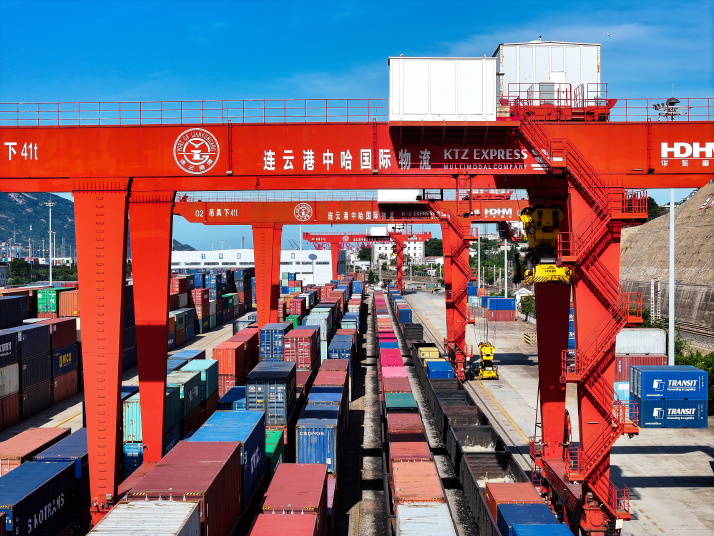| World |
| China and Central Asian countries advance common goals | |
|
|
 Aerial drone photo shows the China-Kazakhstan (Lianyungang) Logistics Cooperation Base in Lianyungang, eJiangsu Province, on July 3. Launched in 2014, the base has become a crucial platform for transit, warehousing and trade between Central Asian countries (XINHUA)
Logistics Cooperation Base in Lianyungang, Jiangsu Province, on July 3. Launched in 2014, the base has become a vital platform for transit, warehousing and trade between China and Central Asian countries.
The Fifth China-Central Asia Foreign Ministers' Meeting, held in the southwestern Chinese city of Chengdu, Sichuan Province, on December 1, saw extensive discussions among the foreign ministers on comprehensively advancing cooperation and making political preparations for the second China-Central Asia Summit scheduled for next year. Chinese Foreign Minister Wang Yi chaired the meeting. Attendees included Kazakhstan's Deputy Prime Minister and Minister of Foreign Affairs Murat Nurtleu, Kyrgyzstan's Minister of Foreign Affairs Kulubaev Zheenbek Moldokanovich, Tajikistan's Minister of Foreign Affairs Sirojiddin Muhriddin, Turkmenistan's Deputy Prime Minister and Foreign Minister Rashid Meredov and Uzbekistan's Foreign Minister Bakhtiyor Saidov. Wang noted that the China-Central Asia Mechanism has been in place for four years, during which the six countries, driven by good neighborliness, solidarity and pragmatism, have worked together to promote its development. He said substantial progress has been made since the first summit in Xi'an, Shaanxi Province, in May 2023, with over half of the related projects being implemented or advancing substantially. The two sides have established ministerial platforms in trade, customs, agriculture, transportation and industrial investment, Wang said, adding that China is willing to enhance cooperation with Central Asian countries and align development strategies. Speaking at the meeting, the foreign ministers of the five Central Asian countries noted that based on the principles of equality and mutual respect, China and Central Asia enjoy a high level of mutual trust and extensive cooperation, establishing an exemplary model of relations among neighboring countries. According to the ministers, the Central Asian countries express their support for China's cooperation proposals and their willingness to collaborate on the Belt and Road Initiative, a China-proposed initiative to boost connectivity along and beyond the ancient Silk Road routes, strengthen law enforcement and security cooperation, and jointly build a China-Central Asia community with a shared future. They also voiced support for China's rotating presidency of the Shanghai Cooperation Organization. (The Shanghai Cooperation Organization was founded in 2001 by Kazakhstan, China, Kyrgyzstan, Russia, Tajikistan and Uzbekistan, and has since expanded to a trans-regional organization with 10 full member states, two observer countries and 14 dialogue partners—Ed.) The six foreign ministers agreed to establish a themed cooperation year every two years, aimed at fostering high-quality development in China-Central Asia relations. Following the meeting, Wang summarized its outcomes and shared the consensus reached during a joint press conference with the foreign ministers of the five Central Asian countries. Wang emphasized the importance of guidance from the heads of state in ensuring the success of the upcoming summit in Kazakhstan next year. He announced that China and Central Asian countries will start drafting primary documents, including a joint summit declaration, an action plan for high-quality Belt and Road cooperation, a permanent good neighborliness and cooperation treaty, and agreements in other major areas. To advance modernization and deepen cooperation on all fronts, Wang outlined six priority areas for collaboration: trade facilitation, industrial investment, connectivity, green mining, agricultural modernization and streamlined people-to-people exchange.  (Above) A visitor selects products at the Central Asia Special Commodity Exhibition and Sales Center during the 11th China-Central Asia Cooperation Forum in Yinchuan, Ningxia Hui Autonomous Region, on October 26 The China-Kazakhstan (XINHUA)
Additionally, Wang stated that China is ready to expand its cooperation with Central Asia in the applications of its BeiDou Navigation Satellite System, similar to GPS of the United States, poverty reduction and alleviation, desertification control, higher education and cultural exchange. He also underscored maintaining regional peace and security, noting that the six countries had agreed to jointly combat terrorism, separatism and extremism, firmly oppose external interference in the internal affairs of Central Asian countries, potentially creating chaos and turbulence in Central Asia, and support Afghanistan in achieving peace and reconstruction. China and Central Asian countries should enhance mutual learning among civilizations and the sharing of governance experiences, Wang said, adding that over the next three years, China will provide 1,500 training opportunities and 600 scholarships for Central Asian countries. In terms of promoting multilateralism, Wang said the six countries had pledged to uphold multilateralism and international fairness and justice. He said the six countries must continue to strengthen coordination in global affairs, as well as solidarity and cooperation among the Global South (regions of the world generally characterized by lower levels of economic and industrial development and often located south of more industrialized nations—Ed.), so as to promote an equal and orderly multipolar world and economic globalization that benefits all. China and Central Asian countries reaffirmed their commitment to preserving peace and security and defending the outcomes of World War II, Wang said. On the same day, the foreign ministers also attended the launch ceremony of the Tianfu cross-border freight truck service to Central Asia. The transport service now connects 20 cities across five Central Asian countries. Plans are being drafted to expand the service to cover major Central Asian cities within three years. Additionally, the ministers inaugurated a China-Central Asia center for the exhibition and promotion of commodities, which features national pavilions for the five Central Asian countries to showcase and promote their products. The center will serve as a new platform for collaboration in trade, education, culture and tourism between China and Central Asia. This is an edited report from Xinhua News Agency (Print edition title: Neighborly Ties in Action) Copyedited by Elsbeth van Paridon Comments to dingying@cicgamericas.com |
|
||
|
||||||||||||||||||||||||||||
|